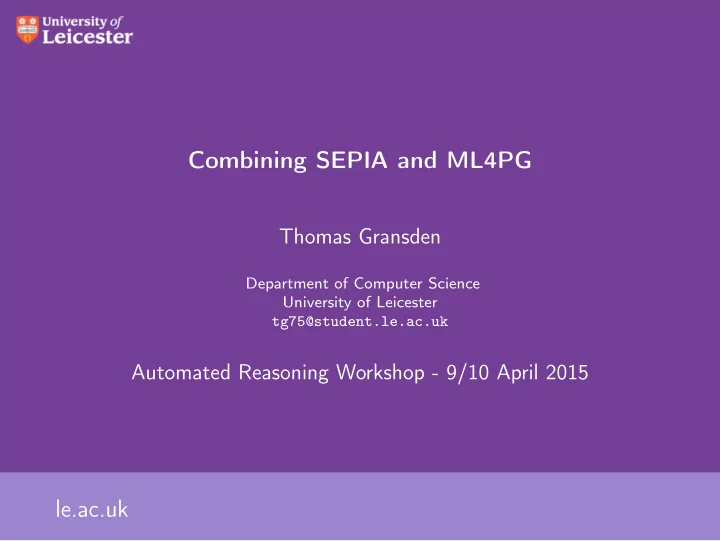

Combining SEPIA and ML4PG Thomas Gransden Department of Computer Science University of Leicester tg75@student.le.ac.uk Automated Reasoning Workshop - 9/10 April 2015 le.ac.uk
SEPIA: An Introduction SE arching for P roofs using I nferred A utomata SEPIA applies model inference techniques to interactive proofs Extended Finite State Machines = tactic sequences + arguments rewrite (p=plus_n_0 || p=plus_n_Sm) 0 1
Theorem Proving Using SEPIA Generate proofs by traversing paths through model Can be used manually (CICM’14) and (even better) automatically (via ProofGeneral)! Inference algorithms model “new” sequences of tactics An unexpected consequence - theory analysis? Inference Process Feel free to discuss this with me during the workshop!
SEPIA: Proof Mode Callable during proof development - uses all previous proofs and any other opened theories
Limitations of SEPIA Exploding State Space SEPIA learns from whole theories of proofs. However more proofs naturally leads to larger models with more redundancy. “Static” Learning Process SEPIA treats the proof script completely textually - so state machine transitions fail if variables are named differently e.g. induction n is not applicable to forall a:nat, a + 0 = a. . How can we circumvent these issues?
ML4PG: Machine Learning for Proof General A ProofGeneral extension that uses machine learning to analyse large corpora of proofs. Combining with ML4PG How can ML4PG help with the issues described previously?
Use Case: Reducing State Space with ML4PG Currently, whole theories are used to infer a model from. There are many proofs that aren’t useful in any one proof derivation. Use ML4PG to identify statistically similar lemmas and infer a model from these suggested lemmas instead of whole theories. This is a nice way of automating ML4PG’s output - something that isn’t currently done.
Use Case: Inferring “Dynamic” models from ML4PG features One of the features that ML4PG extracts is the relation of a tactic argument to a hypothesis or external lemma . We can use this information as input to SEPIA - eventually getting more semantic transitions such as: 1 perform induction on a variable from the goal 2 rewrite using a lemma from a particular cluster
Conclusion We have shown that SEPIA and ML4PG can be used in conjunction with each other. In our future work we plan to rigorously evaluate the combined tools on large scale datasets to show the potential benefits. Questions/Comments Welcome!
Recommend
More recommend